Risk Assessment and Source Identification of 17 Metals and Metalloids on Soils from the Half-Century Old Tungsten Mining Areas in Lianhuashan, Southern China
Abstract
:1. Introduction
2. Materials and Method
2.1. Study Area and Soil Sampling Site
2.2. Sample Collection and Analysis
2.3. Contamination Factor (CF) and Integrated Pollution Index (IPI)
2.4. Enrichment Factors (EFs)
2.5. Statistical and Spatial Distribution Analysis
3. Results
3.1. Metal Concentrations in Three Different Horizon Soils
3.2. Risk Assessment of Metals and Metalloids on Top Soils
3.2.1. CFs and IPIs of Metals and Metalloids in Top Soils
3.2.2. EF Values and Spatial Distribution of Metals and Metalloids in Top Soils
3.3. Source Identification by Multivariate Statistical Analysis
3.3.1. Principle Component Analysis
3.3.2. Cluster Analysis Results
3.4. Chemical Fractionations of Toxic Elements in Three Different Layer Soils
4. Discussion
4.1. Soil Contaminant Risks and Sources
4.2. Fate and Transport of the Metals and Metalloids
4.3. Remediation and Reclaim Implementations
5. Conclusions
Supplementary Materials
Acknowledgments
Author Contributions
Conflicts of Interest
References
- Chen, R.; Sherbinin, A.D. China’s Soil Pollution: Farms on the Frontline. Science 2014, 344, 691. [Google Scholar] [CrossRef] [PubMed]
- Pourret, O.; Lange, B.; Bonhoure, J.; Colinet, G.; Decrée, S.; Mahy, G.; Séleck, M.; Shutcha, M.; Faucon, M.P. Assessment of soil metal distribution and environmental impact of mining in Katanga (Democratic republic of Congo). Appl. Geochem. 2016, 64, 43–55. [Google Scholar] [CrossRef]
- Kouchou, A.; Rais, N.; Elsass, F.; Duplay, J.; Fahli, N.; Ghachtouli, N.E.L. Effects of long-term heavy metals contamination on soil microbial characteristics in calcareous agricultural lands (Saiss plain, North Morocco). J. Mater. Environ. Sci. 2017, 8, 691–695. [Google Scholar]
- Tume, P.; González, E.; King, R.W.; Cuitiño, L.; Roca, N.; Bech, J. Distinguishing between natural and anthropogenic sources for potentially toxic elements in urban soils of talcahuano, Chile. J. Soils Sediments 2017, 1–15. [Google Scholar] [CrossRef]
- Zhou, J.; Feng, K.; Pei, Z.; Meng, F.; Sun, J. Multivariate analysis combined with GIS to source identification of heavy metals in soils around an abandoned industrial area, eastern China. Ecotoxicology 2016, 25, 380–388. [Google Scholar] [CrossRef] [PubMed]
- Wiseman, C.L.; Zereini, F.; Puttmann, W. Metal and metalloid accumulation in cultivated urban soils: A medium-term study of trends in Toronto, Canada. Sci. Total Environ. 2015, 538, 564–572. [Google Scholar] [CrossRef] [PubMed]
- Rosolen, V.; De-Campos, A.B.; Govone, J.S.; Rocha, C. Contamination of wetland soils and floodplain sediments from agricultural activities in the cerrado biome (state of Minas Gerais, Brazil). Catena 2015, 128, 203–210. [Google Scholar] [CrossRef]
- Monterroso, C.; Rodríguez, F.; Chaves, R.; Diez, J.; Becerra-Castro, C.; Kidd, P.S.; Macías, F. Heavy metal distribution in mine-soils and plants growing in a Pb/Zn-mining area in NW Spain. Appl. Geochem. 2014, 44, 3–11. [Google Scholar] [CrossRef]
- Liu, G.; Tao, L.; Liu, X.; Hou, J.; Wang, A.; Li, R. Heavy metal speciation and pollution of agricultural soils along Jishui river in non-ferrous metal mine area in Jiangxi province, China. J. Geochem. Explor. 2013, 132, 156–163. [Google Scholar] [CrossRef]
- Ettler, V. Soil contamination near non-ferrous metal smelters: A review. Appl. Geochem. 2016, 64, 56–74. [Google Scholar] [CrossRef]
- Marrugo, N.J.; Pinedo, H.J.; Diez, S. Assessment of heavy metal pollution, spatial distribution and origin in agricultural soils along the Sinu River Basin, Colombia. Environ. Res. 2017, 154, 380–388. [Google Scholar] [CrossRef] [PubMed]
- Miler, M.; Gosar, M. Characteristics and potential environmental influences of mine waste in the area of the closed mežica Pb-Zn mine (Slovenia). J. Geochem. Explor. 2012, 112, 152–160. [Google Scholar] [CrossRef]
- Acosta, J.A.; Faz, A.; Martínez-Martínez, S.; Zornoza, R.; Carmona, D.M.; Kabas, S. Multivariate statistical and GIS-based approach to evaluate heavy metals behavior in mine sites for future reclamation. J. Geochem. Explor. 2011, 109, 8–17. [Google Scholar] [CrossRef]
- Zhou, J.M.; Dang, Z.; Cai, M.F.; Liu, C.Q. Soil heavy metal pollution around the Dabaoshan mine, Guangdong province, China. Pedosphere 2007, 17, 588–594. [Google Scholar] [CrossRef]
- Courtin, N.A.; Waltzing, T.; Evrard, C.; Soubrand, M.; Lenain, J.-F.; Ducloux, E.; Ghorbel, S.; Grosbois, C.; Bril, H. Arsenic and lead mobility: From tailing materials to the aqueous compartment. Appl. Geochem. 2016, 64, 10–21. [Google Scholar] [CrossRef]
- Ji, K.; Kim, J.; Lee, M.; Park, S.; Kwon, H.J.; Cheong, H.K.; Jang, J.Y.; Kim, D.S.; Yu, S.; Kim, Y.W.; et al. Assessment of exposure to heavy metals and health risks among residents near abandoned metal mines in Goseong, Korea. Environ. Pollut. 2013, 178, 322–328. [Google Scholar] [CrossRef] [PubMed]
- Wuana, R.A.; Okieimen, F.E. Heavy metals in contaminated soils: A review of sources, chemistry, risks and best available strategies for remediation. ISRN Ecol. 2011, 2011, 402647. [Google Scholar] [CrossRef]
- Liu, C.P.; Luo, C.L.; Gao, Y.; Li, F.B.; Lin, L.W.; Wu, C.A.; Li, X.D. Arsenic contamination and potential health risk implications at an abandoned tungsten mine, southern China. Environ. Pollut. 2010, 158, 820–826. [Google Scholar] [CrossRef] [PubMed]
- Li, Z.; Ma, Z.; van der Kuijp, T.J.; Yuan, Z.; Huang, L. A review of soil heavy metal pollution from mines in China: Pollution and health risk assessment. Sci. Total Environ. 2014, 468–469, 843–853. [Google Scholar] [CrossRef] [PubMed]
- IUSS Working Group WRB. World Reference Base for Soil Resources 2014; World Soil Resources Reports 106; Food and Agriculture Organization: Rome, Italy, 2015; pp. 1–203. [Google Scholar]
- China Geological Survey (CGS). Technical Requirements for the Sample Analysis Used for Eco-Geochemical Assessment; DD2005-03, Appendix A; CGS: Beijing, China, 2005; pp. 24–32.
- Tessier, A.; Campbell, P.G.C.; Bisson, M. Sequential extraction procedure for the speciation of particulate trace metals. Anal. Chem. 1979, 51, 844–851. [Google Scholar] [CrossRef]
- Boruvka, L.; Kozak, J.; Kristoufkova, S.; Huan, W.C. Speciation of cadmium, lead and zinc in heavy polluted soils. Rostlinna Vyroba 1997, 43, 187–192. [Google Scholar]
- Mico, C.; Recatala, L.; Peris, M.; Sanchez, J. Assessing heavy metal sources in agricultural soils of an european mediterranean area by multivariate analysis. Chemosphere 2006, 65, 863–872. [Google Scholar] [CrossRef] [PubMed]
- Liu, G.; Yu, Y.; Hou, J.; Xue, W.; Liu, X.; Liu, Y.; Wang, W.; Alsaedi, A.; Hayat, T.; Liu, Z. An ecological risk assessment of heavy metal pollution of the agricultural ecosystem near a lead-acid battery factory. Ecol. Indic. 2014, 47, 210–218. [Google Scholar] [CrossRef]
- China National Environmental Monitoring Centre (CNEMC). The Background Values of Chinese Soils; Environmental Science Press of China: Beijing, China, 1990. [Google Scholar]
- Hakanson, L. An ecological risk index for aquatic pollution control. A sedimentological approach. Water Res. 1980, 14, 975–1001. [Google Scholar] [CrossRef]
- Darwish, M.A.G.; Pöllmann, H. Trace element assessment in agricultural and desert soils of Aswan area, south Egypt: Geochemical characteristics and environmental impacts. J. Afr. Earth Sci. 2015, 112, 358–373. [Google Scholar] [CrossRef]
- Suresh, G.; Sutharsan, P.; Ramasamy, V.; Venkatachalapathy, R. Assessment of spatial distribution and potential ecological risk of the heavy metals in relation to granulometric contents of Veeranam lake sediments, India. Ecotoxicol. Environ. Saf. 2012, 84, 117–124. [Google Scholar] [CrossRef] [PubMed]
- Reimann, C.; Caritat, P.D. Intrinsic flaws of element enrichment factors (EFs) in environmental geochemistry. Environ. Sci. Technol. 2000, 34, 5084–5091. [Google Scholar] [CrossRef]
- Rashed, M.N. Monitoring of contaminated toxic and heavy metals, from mine tailings through age accumulation, in soil and some wild plants at southeast Egypt. J. Hazard. Mater. 2010, 178, 739–746. [Google Scholar] [CrossRef] [PubMed]
- Hu, Y.; Liu, X.; Bai, J.; Shih, K.; Zeng, E.Y.; Cheng, H. Assessing heavy metal pollution in the surface soils of a region that had undergone three decades of intense industrialization and urbanization. Environ. Sci. Pollut. Res. 2013, 20, 6150–6159. [Google Scholar] [CrossRef] [PubMed]
- Cai, L.; Xu, Z.; Bao, P.; He, M.; Dou, L.; Chen, L.; Zhou, Y.; Zhu, Y.G. Multivariate and geostatistical analyses of the spatial distribution and source of arsenic and heavy metals in the agricultural soils in Shunde, southeast China. J. Geochem. Explor. 2015, 148, 189–195. [Google Scholar] [CrossRef]
- Lantzy, R.J.; Mackenzie, F.T. Atmospheric trace metals: Global cycles and assessment of man’s impact. Geochim. Cosmochim. Acta 1979, 43, 511–525. [Google Scholar] [CrossRef]
- Blaser, P.; Zimmermann, S.; Luster, J.; Shotyk, W. Critical examination of trace element enrichments and depletions in soils: As, Cr, Cu, Ni, Pb, and Zn in Swiss forest soils. Sci. Total Environ. 2000, 249, 257–280. [Google Scholar] [CrossRef]
- Xie, Y.; Chen, T.B.; Lei, M.; Yang, J.; Guo, Q.J.; Song, B.; Zhou, X.Y. Spatial distribution of soil heavy metal pollution estimated by different interpolation methods: Accuracy and uncertainty analysis. Chemosphere 2011, 82, 468–476. [Google Scholar] [CrossRef] [PubMed]
- Ha, H.; Olson, J.R.; Bian, L.; Rogerson, P.A. Analysis of heavy metal sources in soil using Kriging interpolation on principal components. Environ. Sci. Technol. 2014, 48, 4999–5007. [Google Scholar] [CrossRef] [PubMed]
- Webster, R.; Oliver, M.A. Geostatistics for Environmental Scientists Statistics in Practice; Wiley: Chichester, UK, 2001; p. 271. [Google Scholar]
- Li, W.; Xu, B.; Song, Q.; Liu, X.; Xu, J.; Brookes, P.C. The identification of ‘hotspots’ of heavy metal pollution in soil-rice systems at a regional scale in eastern China. Sci. Total Environ. 2014, 472, 407–420. [Google Scholar] [CrossRef] [PubMed]
- Chinese Environmental Protection Administration (CEPA). Environmental Quality Standard for Soils; GB15618-2008, revised edition; CEPA: Beijing, China, 2008.
- Guo, X.; Wang, K.; He, M.; Liu, Z.; Yang, H.; Li, S. Antimony smelting process generating solid wastes and dust: Characterization and leaching behaviors. J. Environ. Sci. 2014, 26, 1549–1556. [Google Scholar] [CrossRef] [PubMed]
- Kidd, P.S.; Domínguez-Rodríguez, M.J.; Díez, J.; Monterroso, C. Bioavailability and plant accumulation of heavy metals and phosphorus in agricultural soils amended by long-term application of sewage sludge. Chemosphere 2007, 66, 1458–1467. [Google Scholar] [CrossRef] [PubMed]
- Chai, Y.; Guo, J.; Chai, S.; Cai, J.; Xue, L.; Zhang, Q. Source identification of eight heavy metals in grassland soils by multivariate analysis from the Baicheng-Songyuan area, Jilin province, northeast China. Chemosphere 2015, 134, 67–75. [Google Scholar] [CrossRef] [PubMed]
- Chen, T.; Liu, X.; Zhu, M.; Zhao, K.; Wu, J.; Xu, J.; Huang, P. Identification of trace element sources and associated risk assessment in vegetable soils of the urban-rural transitional area of Hangzhou, China. Environ. Pollut. 2008, 151, 67–78. [Google Scholar] [CrossRef] [PubMed]
- Dudka, S.; Miller, W.P. Permissible concentrations of arsenic and lead in soils based on risk assessment. Water Air Soil Pollut. 1999, 113, 127–132. [Google Scholar] [CrossRef]
- Rosen, C.J. Lead in the Home Garden and Urban Soil Environment, Communication and Educational Technology Services; University of Minnesota Extension: St. Paul, MN, USA, 2002. [Google Scholar]
- Šajn, R.; Gosar, M. Multivariate statistical approach to identify metal sources in Litija area (Slovenia). J. Geochem. Explor. 2014, 138, 8–21. [Google Scholar] [CrossRef]
- Kelepertzis, E. Accumulation of heavy metals in agricultural soils of Mediterranean: Insights from Argolida basin, Peloponnese, Greece. Geoderma 2014, 221–222, 82–90. [Google Scholar] [CrossRef]
- Chandrasekaran, A.; Ravisankar, R. Spatial distribution of physico-chemical properties and function of heavy metals in soils of Yelagiri hills, Tamilnadu by energy dispersive X-ray florescence spectroscopy (EDXRF) with statistical approach. Spectrochim. Acta Part A 2015, 150, 586–601. [Google Scholar] [CrossRef] [PubMed]
- Ağca, N.; Özdel, E. Assessment of spatial distribution and possible sources of heavy metals in the soils of Sariseki-Dörtyol District in Hatay Province (Turkey). Environ. Earth Sci. 2014, 71, 1033–1047. [Google Scholar] [CrossRef]
- Cai, L.; Xu, Z.; Ren, M.; Guo, Q.; Hu, X.; Hu, G.; Wan, H.; Peng, P. Source identification of eight hazardous heavy metals in agricultural soils of Huizhou, Guangdong province, China. Ecotoxicol. Environ. Saf. 2012, 78, 2–8. [Google Scholar] [CrossRef] [PubMed]
- Nicholson, F.A.; Smith, S.R.; Alloway, B.J.; Carlton, S.C.; Chambers, B.J. An inventory of heavy metals inputs to agricultural soils in England and Wales. Sci. Total Environ. 2003, 311, 205–219. [Google Scholar] [CrossRef]
- Bourennane, H.; Douay, F.; Sterckeman, T.; Villanneau, E.; Ciesielski, H.; King, D.; Baize, D. Mapping of anthropogenic trace elements inputs in agricultural topsoil from northern france using enrichment factors. Geoderma 2010, 157, 165–174. [Google Scholar] [CrossRef]
- Cheraghi, M.; Lorestani, B.; Merrikhpour, H. Investigation of the effects of phosphate fertilizer application on the heavy metal content in agricultural soils with different cultivation patterns. Biol. Trace Elem. Res. 2012, 145, 87–92. [Google Scholar] [CrossRef] [PubMed]
- Wang, H.; Dong, Y.; Yang, Y.; Toor, G.S.; Zhang, X. Changes in heavy metal contents in animal feeds and manures in an intensive animal production region of China. J. Environ. Sci. 2013, 25, 2435–2442. [Google Scholar] [CrossRef]
- Lan, H.X.; Hu, R.L.; Yue, Z.Q.; Lee, C.F.; Wang, S.J. Engineering and geological characteristics of granite weathering profiles in south China. J. Asian Earth Sci. 2003, 21, 353–364. [Google Scholar] [CrossRef]
- Carvalho Filho, A.D.; Inda, A.V.; Fink, J.R.; Curi, N. Iron oxides in soils of different lithological origins in Ferriferous Quadrilateral (Minas Gerais, Brazil). Appl. Clay Sci. 2015, 118, 1–7. [Google Scholar] [CrossRef]
- Bech, J.; Reverter, F.; Tume, P.; Sanchez, P.; Longan, L.; Bech, J.; Oliver, T. Pedogeochemical mapping of Al, Ba, Pb, Ti and V in surface soils of Barcelona province (Catalonia, NE Spain): Relationships with soil physicochemical properties. J. Geochem. Explor. 2011, 109, 26–37. [Google Scholar] [CrossRef]
- Tume, P.; Bech, J.; Longan, L.; Tume, L.; Reverter, F.; Sepulveda, B. Trace elements in natural surface soils in Sant Climent (Catalonia, Spain). Ecol. Eng. 2006, 27, 145–152. [Google Scholar] [CrossRef]
- Dankoub, Z.; Ayoubi, S.; Khademi, H.; Lu, S.G. Spatial distribution of magnetic properties and selected heavy metals in calcareous soils as affected by land use in the Isfahan region, central Iran. Pedosphere 2012, 22, 33–47. [Google Scholar] [CrossRef]
- McQueen, K.G.; Scott, K.M. Rock weathering and structure of regolith. Regolith Sci. 2008, 1, 105–126. [Google Scholar]
- Taylor, G.; Eggleton, R.A. Regolith Geology and Geomorphology; Wiley: Chichester, UK, 2001. [Google Scholar]
- Rath, P.; Panda, U.C.; Bhatta, D.; Sahu, K.C. Use of sequential leaching, mineralogy, morphology and multivariate statistical technique for quantifying metal pollution in highly polluted aquatic sediments—A case study: Brahmani and Nandira Rivers, India. J. Hazard. Mater. 2009, 163, 632–644. [Google Scholar] [CrossRef] [PubMed]
- De la Campa, A.M.S.; Sánchez-Rodas, D.; Castanedo, Y.G.; Jesús, D. Geochemical anomalies of toxic elements and arsenic speciation in airborne particles from cu mining and smelting activities: Influence on air quality. J. Hazard. Mater. 2015, 291, 18–27. [Google Scholar] [CrossRef] [PubMed]
- Cullen, W.R.; Reimer, K.J. Arsenic speciation in the environment. Chem. Rev. 1989, 89, 713–764. [Google Scholar] [CrossRef]
- Wang, S.; Wang, Y.; Zhang, R.; Wang, W.; Xu, D.; Guo, J.; Li, P.; Yu, K. Historical levels of heavy metals reconstructed from sedimentary record in the Hejiang River, located in a typical mining region of southern China. Sci. Total Environ. 2015, 532, 645–654. [Google Scholar] [CrossRef] [PubMed]
- United States Environmental Protection Agency (EPA). Treatment Technologies for Site Cleanup: Annual Status Report, 12th ed.; EPA: Washington, DC, USA, 2007; p. 5203.
- Guo, G.; Zhou, Q.; Ma, L.Q. Availability and assessment of fixing additives for the in situ remediation of heavy metal contaminated soils: A review. Environ. Monit. Assess. 2006, 116, 513–528. [Google Scholar] [CrossRef] [PubMed]
- Scragg, A.H. Environmental Biotechnology; Longman Essex: Colchester, UK, 1999; p. 249. [Google Scholar]
- Juhasz, A.L.; Smith, E.; Weber, J.; Naidu, R.; Rees, M.; Rofe, A.; Kuchel, T.; Sansom, L. Effect of soil ageing on in vivo arsenic bioavailability in two dissimilar soils. Chemosphere 2008, 71, 2180–2186. [Google Scholar] [CrossRef] [PubMed]
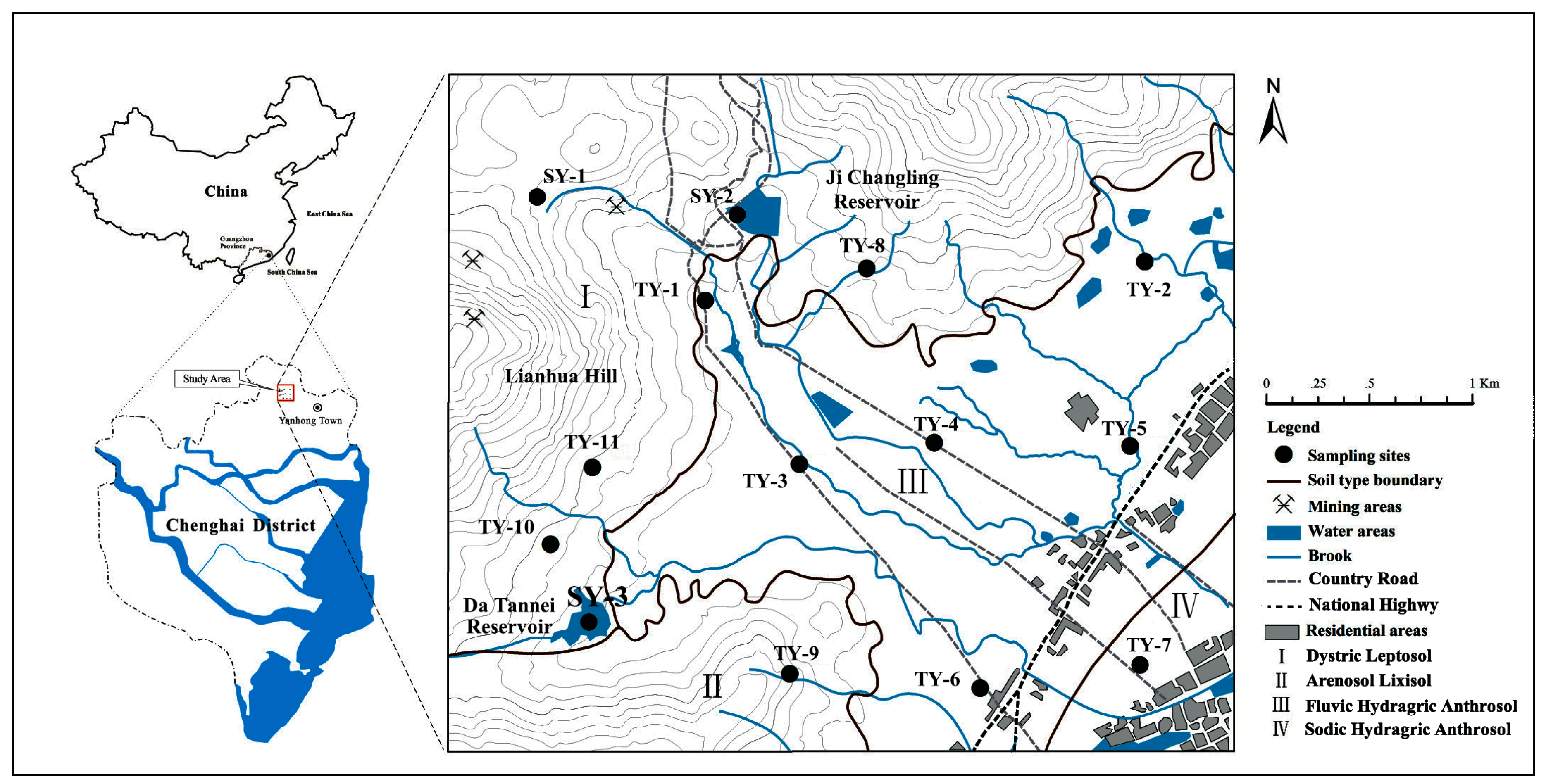
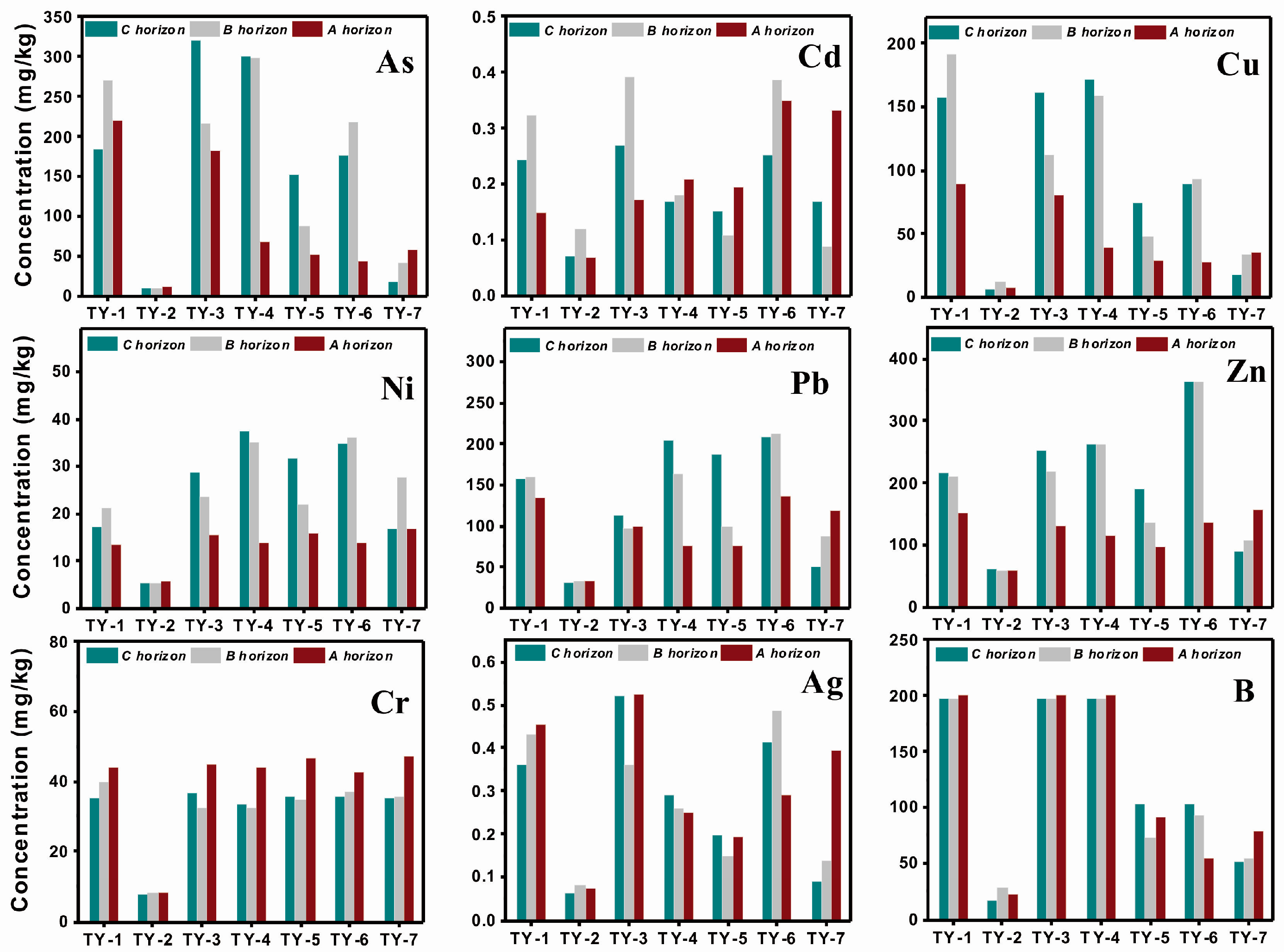

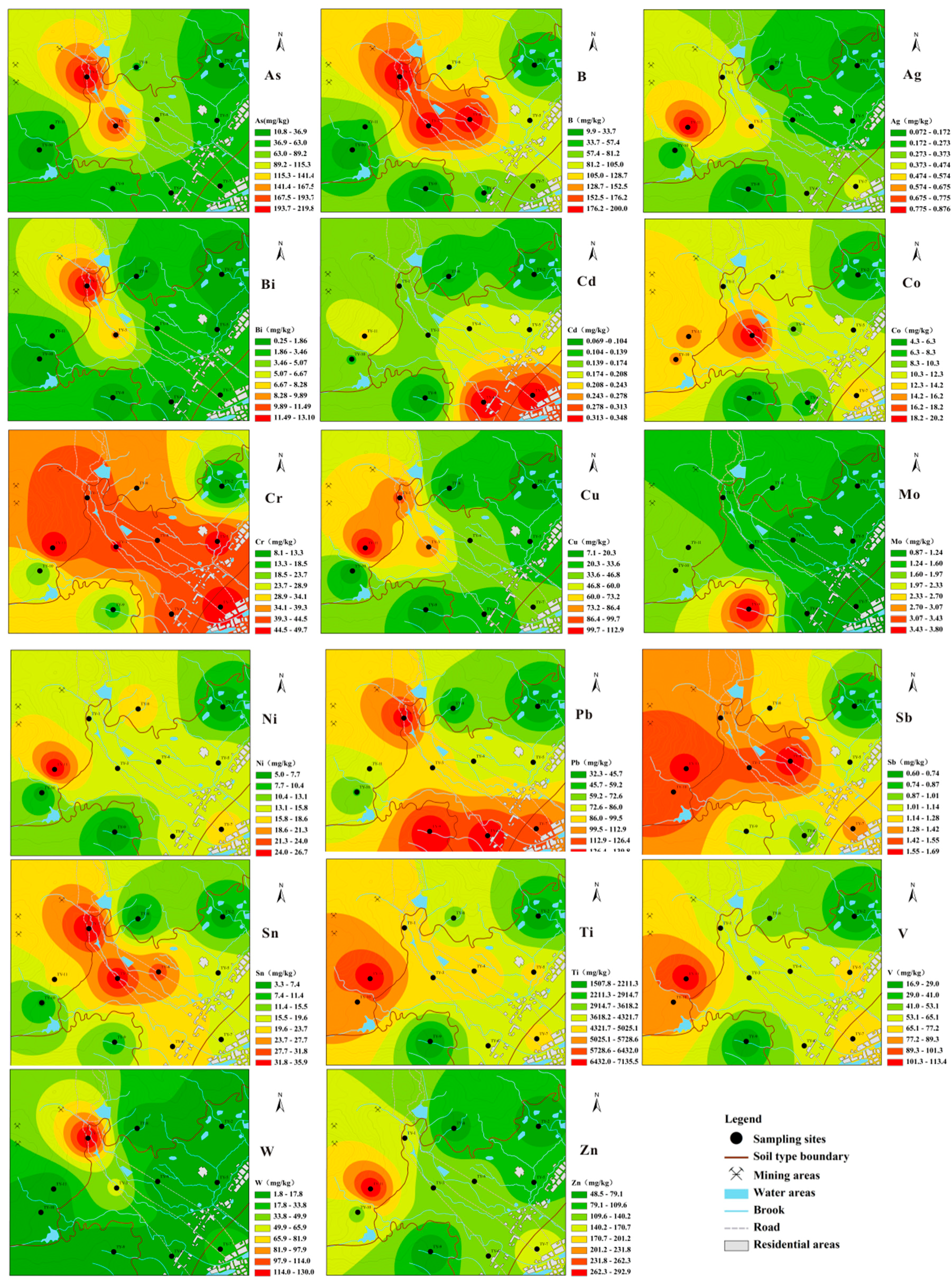
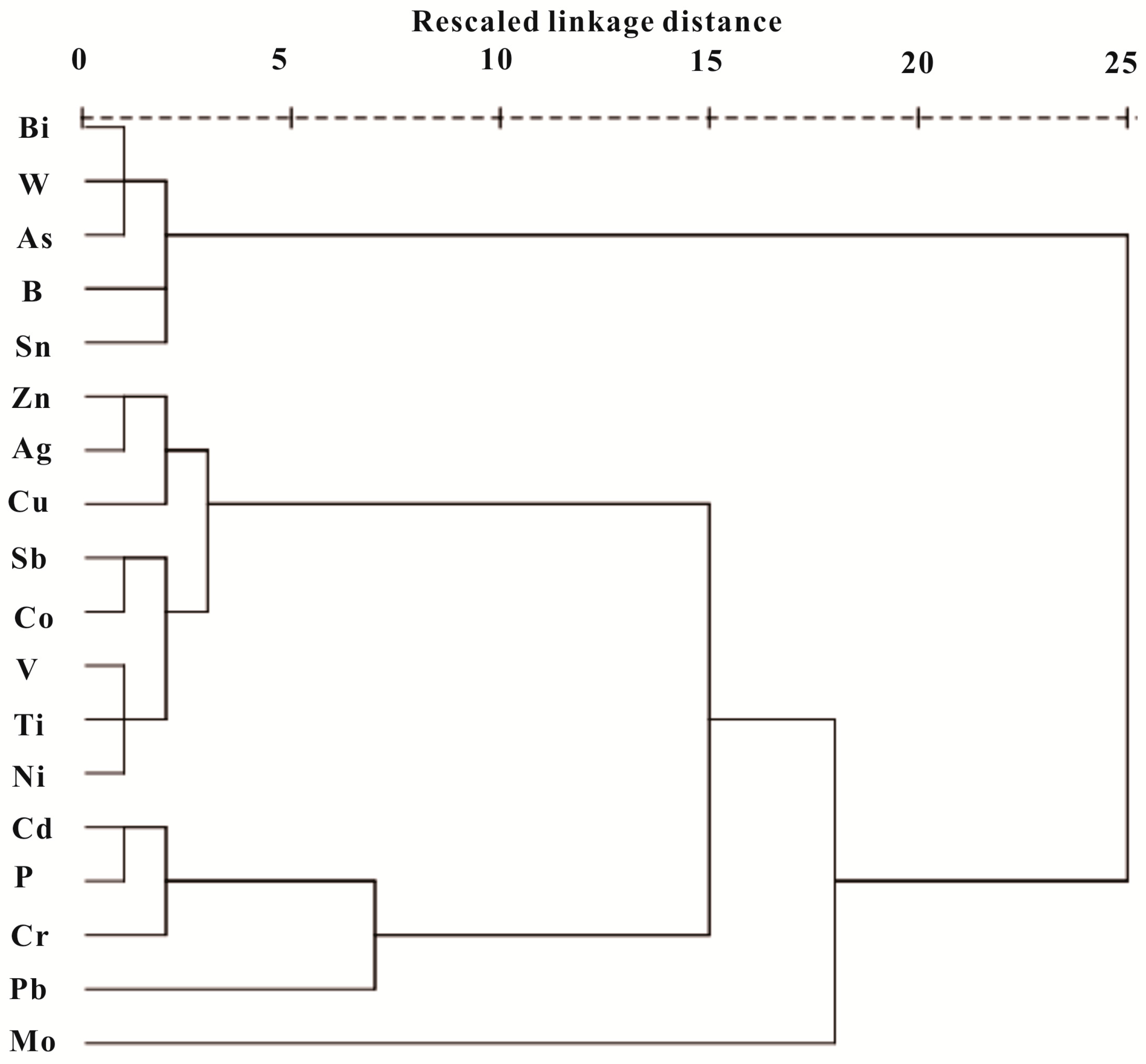
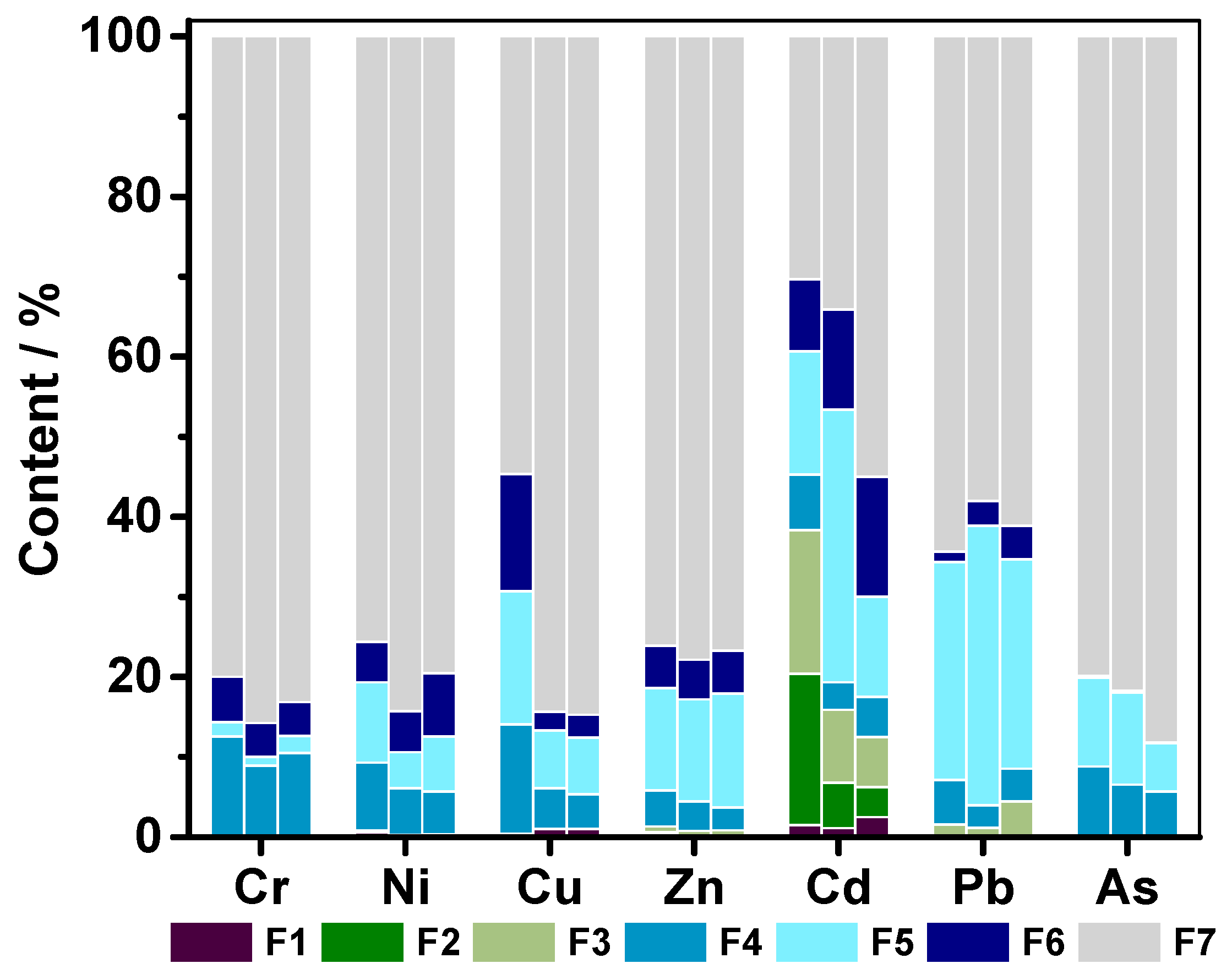
| Site | Geology | Soil Classification a | Land Use | pH | CEC (meq/100 g) | OM (%) |
|---|---|---|---|---|---|---|
| TY-1 | Alluvial clay and gravel () | Fluvic Hydragric Anthrosol | Wild grass | 3.9 | 16.32 | 1.23 |
| TY-2 | Alluvial clay and gravel () | Fluvic Hydragric Anthrosol | Paddy | 4.2 | 17.10 | 3.67 |
| TY-3 | Alluvial clay and gravel () | Fluvic Hydragric Anthrosol | Vegetable field | 4.5 | 16.52 | 3.86 |
| TY-4 | Alluvial clay and gravel () | Fluvic Hydragric Anthrosol | Vegetable field | 4.9 | 17.26 | 3.72 |
| TY-5 | Alluvial clay and gravel () | Fluvic Hydragric Anthrosol | Paddy | 6.2 | 17.32 | 3.62 |
| TY-6 | Alluvial clay and gravel () | Fluvic Hydragric Anthrosol | Paddy | 5.7 | 16.28 | 3.58 |
| TY-7 | Paralic deposits () | Sodic Hydragric Anthrosol | Paddy | 6.8 | 18.96 | 3.46 |
| TY-8 | Late Jurassic monzonitic granites (J3ηγ) | Arenosol Lixisol | Forest field | 5.8 | 17.61 | 2.96 |
| TY-9 | Triassic sandy shales and sandy conglomerate (K1ηo) | Dystric Leptosol | Forest field | 4.7 | 16.48 | 2.67 |
| TY-10 | Early Cretaceous Epoch quartzdiorites (T3G) | Arenosol Lixisol | Forest field | 5.1 | 16.52 | 2.98 |
| TY-11 | Early Cretaceous Epoch quartzdiorites (T3G) | Arenosol Lixisol | Forest field | 4.9 | 16.21 | 3.00 |
| Sample | As | Cd | Cu | Ni | Pb | Zn | ||||||
|---|---|---|---|---|---|---|---|---|---|---|---|---|
| Concentration (mg/kg) | EF | Concentration (mg/kg) | EF | Concentration (mg/kg) | EF | Concentration (mg/kg) | EF | Concentration (mg/kg) | EF | Concentration (mg/kg) | EF | |
| TY-1 | 219.8 ± 0.7 | 19.64 | 0.149 ± 0.003 | 2.12 | 88.7 ± 1.2 | 4.15 | 13.6 ± 0.3 | 0.75 | 133.5 ± 1.2 | 2.95 | 150.7 ± 1.4 | 2.53 |
| TY-2 | 10.8 ± 0.2 | 2.06 | 0.069 ± 0.002 | 2.09 | 7.4 ± 0.1 | 0.74 | 5.6 ± 0.4 | 0.66 | 32.3 ± 0.7 | 1.52 | 59.6 ± 0.8 | 2.14 |
| TY-3 | 181.8 ± 0.4 | 11.90 | 0.171 ± 0.002 | 1.78 | 80.9 ± 0.9 | 2.77 | 15.5 ± 0.2 | 0.63 | 99.0 ± 0.6 | 1.60 | 131.2 ± 0.6 | 1.62 |
| TY-4 | 68.5 ± 0.8 | 4.60 | 0.209 ± 0.009 | 2.23 | 39.3 ± 0.5 | 1.38 | 13.8 ± 0.3 | 0.57 | 75.8 ± 1.6 | 1.26 | 116.4 ± 0.8 | 1.47 |
| TY-5 | 52.4 ± 0.7 | 3.86 | 0.193 ± 0.002 | 2.26 | 28.8 ± 0.4 | 1.11 | 15.8 ± 0.1 | 0.72 | 76.2 ± 1.3 | 1.39 | 97.1 ± 0.9 | 1.35 |
| TY-6 | 43.8 ± 0.2 | 3.78 | 0.348 ± 0.001 | 4.77 | 27.7 ± 0.3 | 1.25 | 13.7 ± 0.5 | 0.73 | 136.8 ± 0.7 | 2.92 | 137.3 ± 0.8 | 2.23 |
| TY-7 | 57.8 ± 0.8 | 4.28 | 0.333 ± 0.004 | 3.92 | 34.6 ± 0.6 | 1.34 | 16.8 ± 0.2 | 0.77 | 118.1 ± 0.9 | 2.16 | 156.4 ± 0.9 | 2.18 |
| TY-8 | 61.6 ± 0.3 | 5.77 | 0.099 ± 0.001 | 1.47 | 11.4 ± 0.3 | 0.56 | 17.4 ± 0.4 | 1.01 | 42.4 ± 0.3 | 0.98 | 61.8 ± 0.6 | 1.09 |
| TY-9 | 35.9 ± 0.2 | 7.76 | 0.072 ± 0.001 | 2.47 | 9.2 ± 0.6 | 1.04 | 5.0 ± 0.1 | 0.67 | 139.8 ± 1.1 | 7.47 | 48.5 ± 0.4 | 1.97 |
| TY-10 | 18.1 ± 0.4 | 1.07 | 0.136 ± 0.002 | 1.28 | 7.1 ± 0.3 | 0.22 | 6.3 ± 0.1 | 0.23 | 58.2 ± 0.6 | 0.85 | 130.3 ± 0.8 | 1.45 |
| TY-11 | 49.2 ± 0.3 | 2.25 | 0.213 ± 0.003 | 1.55 | 112.9 ± 1.2 | 2.70 | 26.7 ± 0.2 | 0.75 | 85.3 ± 0.8 | 0.96 | 292.9 ± 1.5 | 2.52 |
| Max | 219.8 | 19.64 | 0.348 | 4.77 | 112.9 | 4.15 | 26.7 | 1.01 | 139.8 | 7.47 | 292.9 | 2.53 |
| Min | 10.8 | 1.07 | 0.069 | 1.28 | 7.1 | 0.22 | 5.0 | 0.23 | 32.3 | 0.85 | 48.5 | 1.09 |
| Mean | 72.7 | 6.09 | 0.181 | 2.36 | 40.7 | 1.57 | 13.6 | 0.68 | 90.7 | 2.19 | 125.6 | 1.87 |
| SD | 66.23 | 5.41 | 0.093 | 1.07 | 36.8 | 1.17 | 6.3 | 0.19 | 38.0 | 1.90 | 67.1 | 0.50 |
| BV a | 8.9 | 0.056 | 17.0 | 14.4 | 36 | 47.3 | ||||||
| MAC b | 25 | 0.30 | 100 | 50 | 300 | 250 | ||||||
| Sample | Contamination Factors (CFs) | IPIs | ||||||||||||||||
|---|---|---|---|---|---|---|---|---|---|---|---|---|---|---|---|---|---|---|
| As | Cd | Cu | Ni | Pb | Zn | Cr | Ag | B | Bi | Co | Mo | Sb | Ti | V | W | Sn | ||
| TY-1 | 24.70 | 2.66 | 5.21 | 0.94 | 3.71 | 3.19 | 0.86 | 4.20 | 9.17 | 24.26 | 1.67 | 0.16 | 2.61 | 1.65 | 0.92 | 41.27 | 6.19 | 3.36 |
| TY-2 | 1.21 | 1.23 | 0.43 | 0.39 | 0.89 | 1.26 | 0.16 | 0.67 | 1.01 | 0.98 | 0.71 | 0.15 | 1.11 | 0.59 | 0.26 | 0.57 | 1.00 | 0.62 |
| TY-3 | 20.43 | 3.05 | 4.76 | 1.07 | 2.75 | 2.77 | 0.89 | 4.84 | 9.17 | 15.68 | 2.88 | 0.16 | 2.70 | 1.72 | 0.98 | 17.07 | 5.96 | 3.16 |
| TY-4 | 7.69 | 3.73 | 2.31 | 0.96 | 2.11 | 2.46 | 0.87 | 2.31 | 9.17 | 4.93 | 1.43 | 0.11 | 3.13 | 1.67 | 0.92 | 2.44 | 4.98 | 2.10 |
| TY-5 | 5.89 | 3.44 | 1.69 | 1.09 | 2.12 | 2.05 | 0.92 | 1.79 | 4.20 | 3.11 | 1.50 | 0.14 | 2.0 | 1.52 | 1.07 | 3.39 | 2.91 | 1.81 |
| TY-6 | 4.92 | 6.21 | 1.63 | 0.95 | 3.80 | 2.90 | 0.84 | 2.69 | 2.47 | 2.46 | 1.10 | 0.11 | 1.69 | 1.30 | 0.81 | 2.0 | 3.98 | 1.74 |
| TY-7 | 6.49 | 5.95 | 2.03 | 1.17 | 3.28 | 3.31 | 0.93 | 3.65 | 3.63 | 4.93 | 1.89 | 0.14 | 2.43 | 1.52 | 1.11 | 6.48 | 3.31 | 2.30 |
| TY-8 | 6.93 | 1.77 | 0.67 | 1.21 | 1.18 | 1.31 | 0.74 | 1.39 | 4.10 | 0.46 | 1.64 | 0.19 | 2.24 | 1.20 | 0.72 | 0.77 | 0.57 | 1.13 |
| TY-9 | 4.03 | 1.29 | 0.54 | 0.35 | 3.88 | 1.02 | 0.33 | 0.88 | 0.53 | 2.07 | 0.61 | 0.49 | 1.93 | 0.52 | 0.29 | 0.83 | 1.67 | 0.90 |
| TY-10 | 2.03 | 2.43 | 0.42 | 0.44 | 1.62 | 2.75 | 0.37 | 1.50 | 0.45 | 0.87 | 2.04 | 0.25 | 2.85 | 1.90 | 1.30 | 0.65 | 1.19 | 1.05 |
| TY-11 | 5.53 | 3.80 | 6.64 | 1.85 | 2.37 | 6.19 | 0.98 | 8.11 | 2.49 | 4.83 | 2.07 | 0.25 | 2.98 | 2.46 | 1.74 | 2.55 | 3.57 | 2.70 |
| Parameter | PC1 | PC2 | PC3 | PC4 |
|---|---|---|---|---|
| V | 0.937 | −0.052 | 0.188 | 0.098 |
| Ti | 0.937 | 0.124 | 0.129 | 0.172 |
| Zn | 0.864 | 0.044 | 0.384 | −0.122 |
| Ag | 0.824 | 0.282 | 0.358 | −0.136 |
| Sb | 0.783 | 0.286 | −0.104 | 0.037 |
| Ni | 0.753 | 0.051 | 0.377 | 0.219 |
| Co | 0.742 | 0.331 | −0.049 | 0.265 |
| Cu | 0.709 | 0.556 | 0.246 | −0.114 |
| As | 0.165 | 0.969 | 0.039 | 0.061 |
| Bi | 0.175 | 0.966 | 0.070 | −0.044 |
| W | 0.077 | 0.934 | 0.039 | −0.057 |
| B | 0.184 | 0.819 | 0.037 | 0.435 |
| Sn | 0.280 | 0.789 | 0.431 | 0.137 |
| Cd | 0.236 | −0.077 | 0.885 | 0.294 |
| P | 0.438 | 0.169 | 0.841 | 0.120 |
| Pb | −0.104 | 0.433 | 0.694 | −0.499 |
| Cr | 0.553 | 0.332 | 0.560 | 0.349 |
| Mo | −0.091 | −0.154 | −0.254 | −0.900 |
| Eigenvalues | 6.164 | 4.998 | 3.089 | 1.704 |
| % of variance | 34.244 | 27.767 | 17.163 | 9.464 |
| Cumulative % | 34.244 | 62.012 | 79.175 | 88.639 |
© 2017 by the authors. Licensee MDPI, Basel, Switzerland. This article is an open access article distributed under the terms and conditions of the Creative Commons Attribution (CC BY) license (http://creativecommons.org/licenses/by/4.0/).
Share and Cite
Guo, L.; Zhao, W.; Gu, X.; Zhao, X.; Chen, J.; Cheng, S. Risk Assessment and Source Identification of 17 Metals and Metalloids on Soils from the Half-Century Old Tungsten Mining Areas in Lianhuashan, Southern China. Int. J. Environ. Res. Public Health 2017, 14, 1475. https://doi.org/10.3390/ijerph14121475
Guo L, Zhao W, Gu X, Zhao X, Chen J, Cheng S. Risk Assessment and Source Identification of 17 Metals and Metalloids on Soils from the Half-Century Old Tungsten Mining Areas in Lianhuashan, Southern China. International Journal of Environmental Research and Public Health. 2017; 14(12):1475. https://doi.org/10.3390/ijerph14121475
Chicago/Turabian StyleGuo, Li, Weituo Zhao, Xiaowen Gu, Xinyun Zhao, Juan Chen, and Shenggao Cheng. 2017. "Risk Assessment and Source Identification of 17 Metals and Metalloids on Soils from the Half-Century Old Tungsten Mining Areas in Lianhuashan, Southern China" International Journal of Environmental Research and Public Health 14, no. 12: 1475. https://doi.org/10.3390/ijerph14121475




